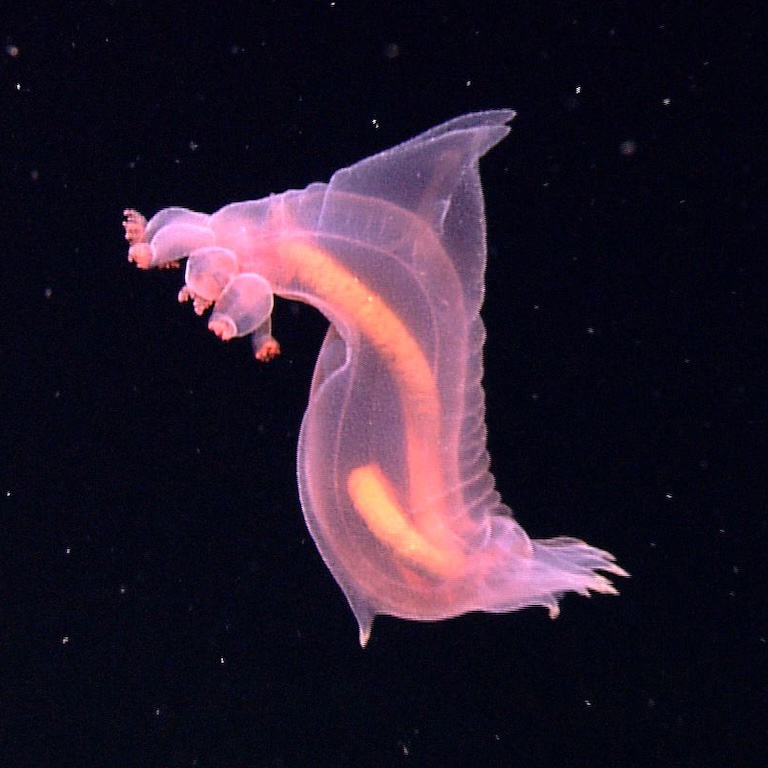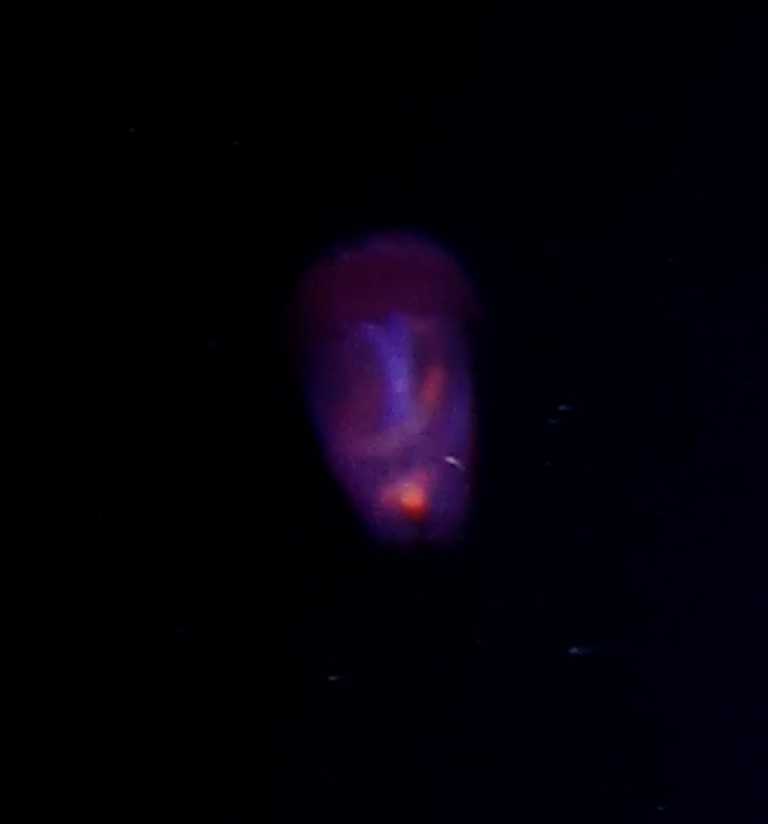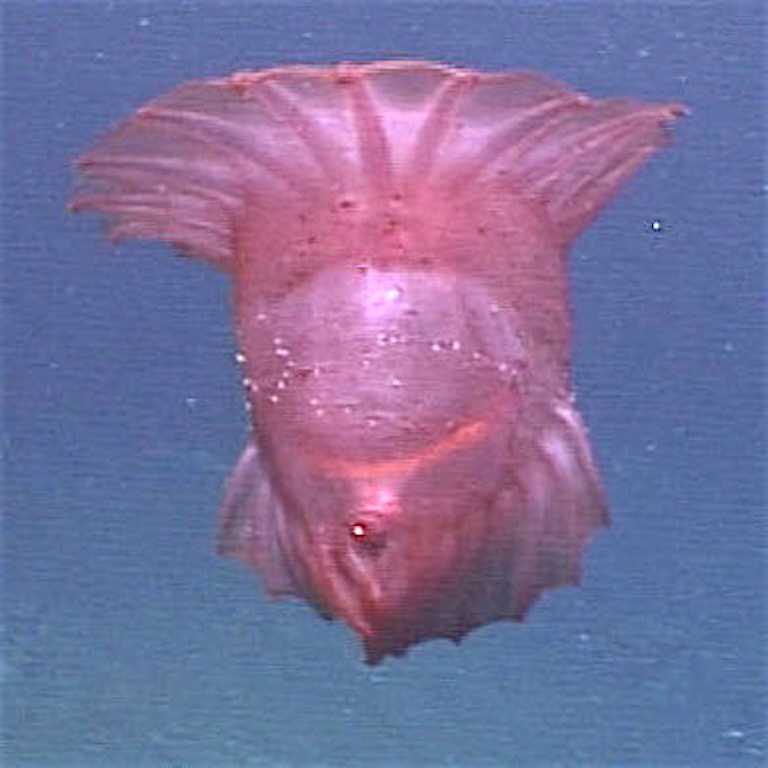Pink See-through Fantasia Profile
As we know, plants are very, very boring. This is why there’s no FactPlant website full of fascinating information about them, and why only cats and nuns can get excited by cucumbers.
But should this humble gourd be caught swimming it would certainly be worth writing a blog post about.
Sea cucumbers aren’t real cucumbers, but they can still be quite unsettling. One in particular, the so-called Spanish Dancer, goes by many other names, ranging from the terrifying “headless chicken fish” to the Ende-esque “pink see-through fantasia”.
And what makes this one more upsetting than your average grocery-store sea cucumber is that it can jump off the continental vegetable shelf and move around on its own.

Pink See-through Fantasia Facts Overview
| Habitat: | Deepsea marine, 461-5,689 m |
| Location: | Caribbean waters, East Antarctica, likely widespread elsewhere |
| Lifespan: | Unknown |
| Size: | 11 to 25 cm (4.3 to 9.8 in) |
| Weight: | Unknown |
| Colour: | Mostly translucent reddish-brown to bright pink |
| Diet: | Organic sediments from the sea floor |
| Predators: | Unknown |
| Top Speed: | Slow |
| No. of Species: | 1 |
| Conservation Status: | Not Listed |
Swimming sea cucumbers sounds like an exclamation suitable for a Warner Brothers cat, but that’s exactly what the pink see-through fantasia is, and it only gets weirder from there.
These echinoderms are relatives of the humble starfish, and more closely related to the sea cucumbers found in the shallows that are known for puking up their intestines and not doing very much else.
But compared with the slow, benthic cucumbers we’re used to, these ones are highly active and much deeper-living, having only been seen in the wild by submersibles a handful of times.
Interesting Pink See-through Fantasia Facts
1. They’re not real cucumbers
Cucumbers are members of the gourd family, and diverge from the ancestors of sea cucumbers around 1.6 billion years ago, at least. This is significantly longer than the divergence of all animals from one another, as cucumbers are, indeed, plants.
Sea cucumbers, then, share nothing in common with Asda cucumbers other than their shape and name, and are actually members of the echinoderm phylum, along with starfish and sea urchins.
This phylum is the most packed with animals of all the exclusively marine phyla, and members are characterised by a shallow skeleton just under the skin.
Holothuroidea is a class of echinoderms, commonly found to be long, chunky and cylindrical, with rounded ends, which, combined with their lack of enthusiasm, vaguely resemble cucumbers, and this lends them the nickname.
This is unusual for an echinoderm, as they’re mostly circular and radially symmetrical, at least as adults, but the sea cucumbers aren’t known to follow trends, and as we go further down the taxonomic rankings it only gets more obvious.
The Holothurioidean order Elasipodida is a group of sea cucumbers who reject the cucumber approach entirely and instead go for tentacles, sails, and fins and other strange appendages.
Most are deep-sea animals, capable of some form of benthic locomotion. The pink see-through fantasia is a member of this group and looks more like a squid than either a cucumber or a sea cucumber. And unlike terrestrial cucumbers, you don’t have to cut them open to have a look inside.
2. You can see inside them
These strange animals are almost transparent but for their digestive systems and a handful of valves that make their innards look like a radial engine.
This does make it a lot easier to infer things about its physiology without having to kill it and makes it look a bit like a spooky ghost with a poo inside it.
3. They eat floor dust
Somewhat like their terrestrial namesakes, sea cucumbers get their nutrients from the organic layer beneath them. Pink see-through sea cucumbers make this very obvious.
There is clear footage of this species feeding on the sea floor, in which the animal is seen using fingered tentacles to grab little fistfuls of sea dust from the floor and stuffing it into its feeding hole.
This nutritionally poor diet likely requires a lot of stuffing the gut, and the animal does indeed look voracious. But ground feeding on dirt is very much a sea cucumber thing. What makes this species weird is that when it’s done, it can jump up and fly away. 1 2
4. They can swim
Pelagothuria is so far the only known echinoderm that is truly pelagic – that is, living entirely in the open ocean.
But the fantasia, while technically a benthic, or ocean-floor, species, is very capable of swimming. This dodgy cucumber uses its special fins to propel itself up off the sea floor and around the ocean.
Its body is just slightly denser than the surrounding water, meaning it weighs almost nothing and can propel itself with ease as a result. With flight being this accessible, it’s no surprise that this species does it often.
In one survey, around three-quarters of the individuals found were swimming, compared with around 23% walking along the sea floor, though it’s not obvious how much of an effect the scary robot submersible had on their urge to swim.
5. They glow in the dark
Affordable submersibles are rapidly emerging as the cutting edge of in-situ marine biology, especially in deeper waters where the very real risk of implosion often makes insurance alone prohibitively expensive for human trips.
This is how a lot of weird marine cucumbers are studied alive, and it tells us significantly more about their behaviour than the strategy of bringing them up in nets, where they have the behavioural repertoire of an actual cucumber on account of them being very dead.
And this is exactly how marine biologists discovered that the pink see-through fantasia produces its own light! 3

6. They shed their skin
This bioluminescence is triggered when the animal is disturbed, suggesting strongly that it is a mechanism of defence. In the deepest, darkest ocean, vision has to be highly attuned to the faintest of lights, so a sudden flash can understandably be overwhelming to such an eye.
The gelatinous “shell” of this animal is where the glow happens, and the glow begins at the point of contact and spreads across the whole body.
This fragile layer appears to be detachable, and could therefore serve as the ink defence in a squid – by leaving a distraction and obstruction behind while the fantasia escapes.
7. Juveniles may be more floaty
While the adults are known for their long jumps, the juveniles may well be entirely independent of the ground. Some have been found more than 3 km from the sea floor, even in surface waters in their larval form, suggesting they descend to the depths as they get older.
Being able to float about in the upper regions of the ocean might be the key to becoming widely distributed, and the known range of this species certainly appears to be expanding
8. They’ve been found in Antarctic waters
The cool thing about the deep ocean is its temperature. The well-known Caribbean habitat of this species may sound balmy but at the depths it prefers there’s little difference in temperature between Antigua and Antarctica, and as it happens, this weird cucumber has been found closer to the South Pole, too.
For such a seemingly soft and fragile animal, the pink see-through fantasia is remarkably hardy! 4

Pink See-through Fantasia Fact-File Summary
Scientific Classification
| Kingdom: | Animalia |
| Phylum: | Echinodermata |
| Class: | Holothuroidea |
| Order: | Elasipodida |
| Family: | Pelagothuriidae |
| Genus: | Enypniastes |
| Species: | eximia |
Fact Sources & References
- SciNews (2019), “Enypniastes eximia feeding”, YouTube.
- Merrit Kennedy (2018), “Behold The Headless Chicken Of The Deep Sea”, npr.
- Suguru Ohta (1985), “Photographic observations of the swimming behavior of the deep-sea pelagothuriid holothurianEnypniastes (Elasipoda, Holothurioidea)”, Springer Nature Link.
- Ashley May (2022), “Researchers just found a bizarre ‘headless chicken monster’ swimming deep in the Antarctic Ocean”, USA Today.
